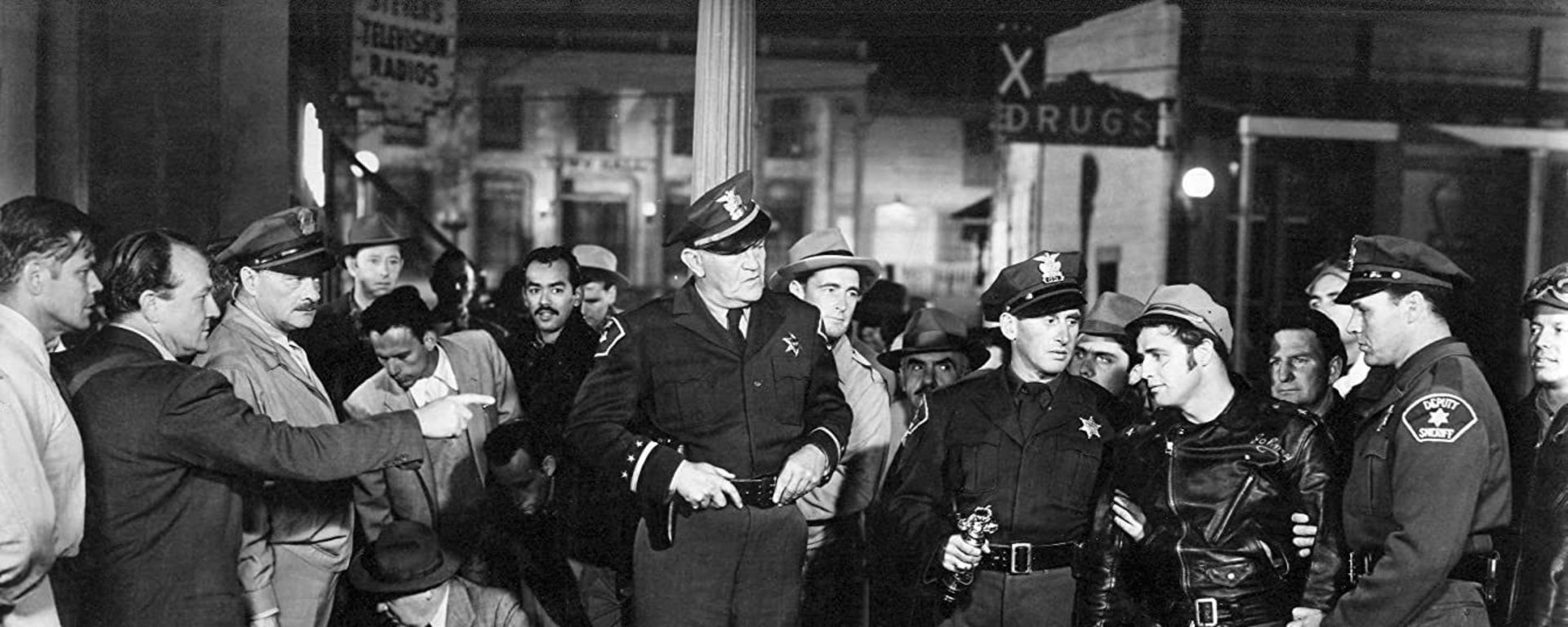
The Wild One
Laslo Benedek’s 1953 film was one of the most controversial of its era, as it was released in the time of a ‘moral panic’. Post war American and British teenagers alarmed their elders in a way that was probably unprecedented and from which we still see some of the ripples in popular culture today.
The 1950s was a time of profound social change and the experience of what it meant to be young was transformed, as many of the old certainties and habits disappeared in the new consumer age. Indeed, the notion of the ‘teenager’, with his or her own clothes, music and interests, was largely a post war creation. Before 1939, broadly speaking, each generation dressed in a largely similar fashion, listened to the same kind of music, went to the same pubs, music halls and so on.
After the end of the Second World War, however, cultural change picked up pace and the newly affluent teens, with increasing time and money on their hands demanded more out of life than their parents had, and rejected many of the old habits and styles. This new air of liberation sometimes expressed itself as an antisocial rebelliousness that turned into outright hooliganism and violence at dance halls playing the newly popular ‘Rock and Roll’ music.
In England the ‘Teddy Boys’ were the most visible and alarming expression of the new youth culture, with their distinctive dress style and apparent willingness to fight and brandish knives. In America disaffected soldiers who found life tough after returning from the European conflict formed their own subcultural groups, such as ‘Greasers’ and the ‘Hells Angels Motorcycle Club’. It was the latter that inspired and informed The Wild One and made its star, Marlon Brando, a popular icon of his time, along with James Dean and Marilyn Monroe.
Brando, as Johnny Strabler, leads the Black Rebels Motorcycle Club into a peaceful American town, and terrorises the inhabitants with their machismo antics and disaffected attitudes. The film was inspired by a real news story from 1947 when possibly three thousand or more motorcyclists descended on the small Californian town of Hollister and reportedly ran amok for three days (see Hunter S. Thompson’s book ‘Hell’s Angels’ for a fuller description of events).
One of the film’s most famous scenes features Brando looking on insouciantly as gang members dance to a juke box in a diner they have taken over. ‘What are you rebelling against Johnny?’ a girl asks him. ‘Waddaya got?’ drawls the handsome young star. It was such apparently antisocial and nihilistic attitudes that thrilled young audiences and appalled their elders.
The film was banned by the BBFC upon its release here and remained so (except for screenings in film societies where local councils overturned the BBFC’s decision) until 1967 when it was released with an X certificate (suitable for 16 year olds and above).
The initial ban was prompted mostly by a fear that the very real problem of burgeoning juvenile delinquency, and a seemingly increasing lack of respect for authority, could only be aggravated by young people seeing this film.
The formal letter of rejection states that the BBFC was of the opinion that the film presents a “spectacle of unbridled hooliganism… with no more than a mild censure from a police officer, would be likely to exert a harmful influence in that very quarter about which anxiety is felt and would expose the Board to justifiable criticism for certificating a film so potentially dangerous on social grounds”. The proliferation of youth styles and subcultures in the 1960s and pitched battles between Mods and Rockers did little to ease the fears of British society, and the BBFC remained cautious in its approach to The Wild One for over a decade, until its fashions and attitudes were seen as too dated to appeal to the new generation of would-be juvenile delinquents.
In the meantime, Columbia Pictures and the director of the film worked hard at getting the ban rescinded, looking in turn at cuts, amendments (including a new ending with Johnny and his gang being sentenced in court) and justifications for the film’s content. Benedek stated in print that he regretted the BBFC banning the film here, and that “somewhere my collaborators and I have not succeeded in convincing those guardians of the British way of life of the sincerity of our purpose”.
It was passed PG on video in 1988, where it sits today on DVD. By today’s standards the film appears quite tame, and it is fairly obvious that its inherent ‘message’ is that people such as Johnny and his ilk turn to gangs as a surrogate family and that society needs to embrace them, rather than push them further into the margins. It is a debate that troubles us still.